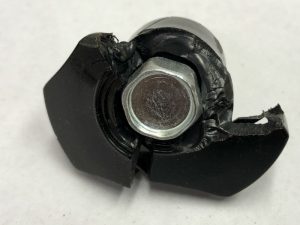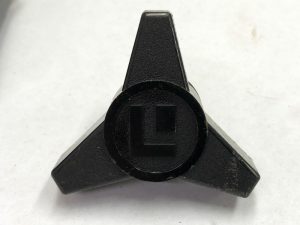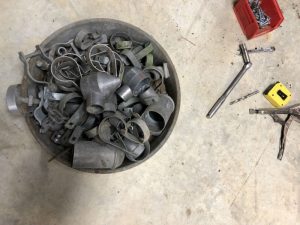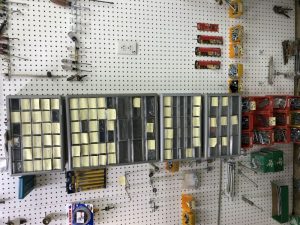I admit to being one, and I’m going to submit strong evidence in support of you being one, too.
As many of you know, one of my interests is birding. “What is birding?” some of you are asking. My earliest avian-studies mentor, the late Judith Toups, used to say there were three levels of bird-interest enthusiasts.
The first was backyard birdwatchers. These are folks who feed birds and look out at the feeder on a somewhat regular basis, but they’re not going beyond the yard to make a feathered friend.
The second level is a birdwatcher, no qualifying adjective. Birdwatchers typically have a pair of binoculars and may infrequently go on outings to find and look at birds.
The third level is birders. Think “woodworkers.” Obsessed. Willing to spend large amounts of money on equipment. Able to spend hours and hours in pursuit of perfection. I think the woodworkers in the audience have the concept.
A few months ago, my wife, Brenda, and I went on a trip, a vacation, a chance to sit around and do nothing.
Unfortunately, doing nothing is not something I’m good at. Fortunately, the place we went has good birding, so I had plenty to do. Being a beach location, one can sit in his condo and watch osprey, gulls of several species, egrets, herons and other shorebirds without ever leaving his room. It’s almost like doing nothing, while expending just a little effort.
I did some of that, but I also spent a good bit of time wandering the island in a more adventurous mode. That meant a backpack, water, binoculars, camera, spotting scope, a tripod and lightweight portable seat. About a 26 pound load.
To get all that stuff to and from the destination, I used all of the skills my Navy corpsman father taught me about packing a suitcase. My tripod was nestled in one leg of a pair of jeans, and the seat was in the other leg, with all of that surrounded by other clothing. Somehow, on the return trip, baggage handlers managed to break the plastic handles on a wing nut which was part of my tripod.

My tripod is old, a Vivitar that is no longer manufactured, and the Vivitar company is out of business. In other words, replacement parts are not available. How was I going to fix this crucial adjustment part?
Of course, when I returned home, the first order of business was business. After 8 days out of town, there were plenty of appointments when Monday morning came calling.
Likewise for Tuesday through Saturday.
But, Saturday afternoon I had time to visit the garage and begin to ponder a repair process. Step One was to determine the thread type. Good! It wasn’t metric! That piece of information alone gives you a hint as to how old the tripod must be.
Since a 5/16″ nut fit on the broken wing nut, which is actually a bolt, I began looking at my supply of adjustment knobs I keep for assemblies. Darn! I had every configuration of knob except one that would work.
Plan B: Dig through the supply of 5/16″ bolts and figure out a way to attach a “handle” to it. Then, what should appear in the pile, but the attachment knobs to my old Lowrance paper graph. Non-fishermen call them “fish finders.” When that albatross died, the only usable parts were the “U” bracket it was mounted in and the knobs that attached it to the bracket.
Moment of truth: will the threaded part be the right length? It worked!

I’d saved those knobs for over 20 years, but the effort finally paid off. This Lowrance part was going to save my Vivitar tripod!
A week or so later I found myself looking for old, saved valuables again. The chain-link fence gate at our clinic had rusted and needed to be rebuilt. Having installed the original fence, I knew I had fence parts somewhere. Out of a pan of elements I was able to find enough corners and brackets that all I had to buy was some new pipe.

“Thar’s gold in that-there pan!” I just had to save those parts a few decades to come up with an almost free new gate.
“Never throw anything away.”
Having been raised by five children of the Depression, I’ve heard that all of my life.
In the span of a couple of weeks, the practice proved itself right again.

While many of these little plastic drawers have new supplies in them, there is a lot of vintage treasure, too.
Jim Randolph is a veterinarian in Long Beach, Mississippi. His earlier careers as lawn mower, dairy farmer, automobile mechanic, microwave communications electronics instructor and journeyman carpenter all influence his approach to woodworking. His favorite projects are furniture built for his wife, Brenda, and for their children and grandchildren. His and Brenda’s home, nicknamed Sticks-In-The-Mud, is built on pilings (sticks) near the wetlands (mud) on a bayou off Jourdan River. His shop is in the lower level of their home.Questions and comments on woodworking may be written below in the comments section. Questions about pet care should be directed to his blog on pet care, www.MyPetsDoctor.com. We regret that, because of high volume, not all inquiries can be answered personally.


I know someone who could have conservatively been generating another 2K per month from rentals for the last 20 years if it were not for pack rat keep everything mentality. There is a cost to keeping stuff. In this persons case, the extra monthly income vastly exceeded the value of the contents. I’m not saying all folks have this issue. Just be aware of how much space your stuff takes up and what that space may be used for.
Yup. Been a packrat all my life. Parents were as well. My brother as well. Doesn’t stop us from being a bit creative, such as creating new camera parts out of Devcon and scrap bits of wood, plastic or metal
But having stuff to rummage through does save time and creative energy
A definite yes. I am a packrat, raised and trained by two preceding generations of packrats: depression-era folks. Just last week I needed to make a repair and, raiding my collection found some pieces that I’m sure I have had for a handful of decades. Lacking which, I’m not sure I could have made a repair, economically, if at all.
And, I freely dispense odd pieces of material, hardware and etc. to younger friends and neighbors from “Uncle Dave’s Hardware Stash”. Fellow Packrats; share, teach, help others similarly inclined to cultivate the habit of saving stuff.
Yes, I am. So is my wife. We are also children of depression era folks and nothing was wasted if at all possible. I grew up in a log house on 180 acres of farm/ranch land in Wyoming. You learned to make what you needed out of what you had. I remember when I was around 14 ‘we’ decided I needed a bedroom added on to the house. My job for the next couple of weeks? Straighten out cans of bent nails. We still have bits and pieces from before we were married that we have hauled all over the US (we’ve been married going on 46 years).
Our motto is “Never throw anything away, just build more from sheds.”
My grandmother lived next door to us (was one of my fondest memories and blessings to have her so close and to spend so much time with her). She was born in 1904 and got married in the 1930s. Her and my grandfathers income had to support 6 other extended family members during the depression.
Though she grew up poor, they made a very comfortable life after the war years. She too, was heavily influenced by the Great Depression. Living next door and basically living with her, I got to see it first hand. She was save all the rubber bands off of newspapers. She would reuse and rewash and hand dry plastic bags. Bits of string were kept as well.
She even relayed stories of local folks trapping rats and eating them during the depression.
It seems many who went through it were heavily influenced by that event.
I’m a hardware pack rat. Depending on what we are doing I save different stuff. We had a small farm until the kids grew into teenagers. Back then I saved pulleys, belts, sprocket and chains. That ended 25 years ago. Now I save hinges and other cabinet hardware. My wife often comments how much junk I have but its worth it if something from your stash saves a trip to the hardware store or junk yard. We just recycled most of the stuff from the farm years.